Archived Storm Damage Blog Posts
Winter Storm Damage Restoration for Homes in South Baton Rouge
1/14/2025 (Permalink)
Winter storms can wreak havoc on residential properties, causing unexpected challenges like roof damage, water intrusion, and burst pipes. If your home in South Baton Rouge has been impacted by severe winter weather, SERVPRO of South Baton Rouge is here to help with expert winter storm damage restoration services.
Our restoration process starts with a detailed assessment of the damage, allowing us to develop a tailored plan for your property. From water removal and structural drying to repairing storm-related damage, our team uses advanced equipment and proven techniques to ensure a thorough recovery. We also focus on preventing long-term issues like mold growth, which can result from lingering moisture.
SERVPRO of South Baton Rouge understands how stressful property damage can be, especially during the winter months. That’s why we’re available 24/7, ready to respond quickly and minimize disruption to your home and life. Our goal is to restore your property to its pre-damage condition as efficiently and effectively as possible.
Don’t let winter storm damage compromise the safety and comfort of your home. Whether it’s frozen pipes, flooding, or other storm-related issues, you can trust us for reliable and professional restoration services. Contact us today to make the damage “Like it never even happened.”
Storm Water Damage Restoration by SERVPRO of South Baton Rouge
1/7/2025 (Permalink)
Severe storms can cause significant water damage to your property, leaving behind flooding, leaks, and moisture buildup. SERVPRO of South Baton Rouge specializes in storm water damage restoration, offering fast and reliable services to protect your home from further damage.
When storms strike, it's crucial to act quickly to prevent mold growth and structural issues. Our expert team provides comprehensive storm water damage restoration, including water extraction, drying, and cleanup, ensuring your property is restored to its original condition.
SERVPRO of South Baton Rouge is available 24/7 for emergency storm damage restoration services. Our professional technicians are trained to handle storm-related water damage, providing peace of mind during stressful situations.
Don’t let storm damage ruin your home—contact us today for fast, efficient storm water damage restoration!
Mold Remediation After Storms and Flooding: Protecting Your Home
1/4/2024 (Permalink)
Storms and flooding can wreak havoc on our homes, leaving behind not only visible damage but also unseen threats. One of the most common and potentially dangerous consequences of water damage is mold growth. When left unattended, mold can cause various issues and structural damage. In this blog, we will explore the importance of mold remediation after storms and flooding, and how taking swift action can protect your home and safeguard your health.
Understanding the Risks of Mold After Storms and Flooding
- Explaining how excess moisture from storms and flooding creates an ideal environment for mold growth.
- Discussing the various types of mold commonly found after water damage and their potential health implications.
- Highlighting the importance of early detection and addressing mold issues promptly to prevent further damage.
The Dangers of Mold to your home
- Discussing how mold can weaken the structural integrity of your home and compromise its value.
- Emphasizing the importance of addressing mold growth to preserve the integrity of your living space.
Professional Mold Remediation Services
- Exploring the expertise and specialized equipment that professional mold remediation companies bring to the process.
- Discussing how experienced professionals can accurately assess the extent of the mold problem and develop a comprehensive remediation plan.
- Highlighting the benefits of hiring professionals, including their knowledge of effective mold removal techniques and their ability to minimize the likelihood of mold recurrence.
Steps in Mold Remediation After Storms and Flooding
Outlining the key steps involved in the mold remediation process, such as containment, air filtration, removal of affected materials, and thorough cleaning. Explain the importance of addressing the underlying cause of the mold growth, such as water intrusion or excessive moisture, to prevent future issues. Educate homeowners on the significance of proper disposal of mold-infested materials in a safe and regulated manner.
Preventive Measures to Avoid Future Mold Growth
- Providing practical tips to reduce the risk of mold growth in the future, such as maintaining proper ventilation, monitoring indoor humidity levels, and promptly addressing water leaks or damage.
- Highlighting the role of professional inspections and regular maintenance in detecting any potential mold issues before they escalate.
- Encouraging homeowners to be proactive in taking preventive measures to ensure a mold-free environment and protect their homes.
Mold growth after storms and flooding can be a significant concern for homeowners, but with prompt and professional mold remediation, the risks can be minimized. By understanding the dangers of mold to your home, and by enlisting the services of experienced professionals, such as SERVPRO of South Baton Rouge, you can safeguard your property and create a healthier living environment. Don't underestimate the importance of mold remediation after storms and flooding – take action today to protect your home and the well-being of your loved ones.
Battling Mold After A Storm
9/16/2023 (Permalink)
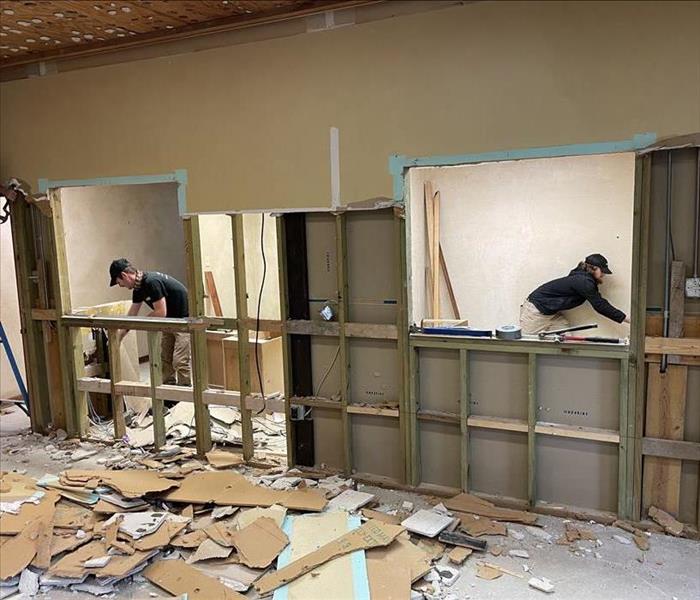 Mold growth is a common issue following water damage.
Mold growth is a common issue following water damage.
When the skies clear after a storm or flooding in Baton Rouge, the immediate concerns may seem to fade away. However, the aftermath often leaves a hidden threat that can affect your home: mold. Mold growth is a common issue following water damage, and it's crucial for Baton Rouge homeowners to understand the risks and take proactive steps to address mold remediation. In this guide, we'll walk you through the process of mold remediation after storms and flooding, helping you safeguard your property and restore a healthy living environment.
Recognizing the Signs of Mold Infestation
Mold is a type of fungus that thrives in damp, humid environments. After a storm or flooding, your Baton Rouge home could become a breeding ground for mold if not properly addressed. Keep an eye out for the following signs that indicate mold may be present:
Musty Odor: A strong, musty smell is often a clear indication of mold growth. If you notice an unusual odor, investigate further.
Visible Mold: Mold can appear as discolored patches on walls, ceilings, and other surfaces. Pay close attention to areas that were exposed to water during the storm.
Act Quickly: The Importance of Timely Mold Remediation
Addressing mold growth promptly is essential to prevent it from spreading and causing further damage. Mold spores can spread through the air and settle in other areas of your home, exacerbating the problem. Swift action is crucial to minimize the extent of the infestation.
DIY vs. Professional Mold Remediation
While minor mold issues can sometimes be addressed with DIY methods, larger infestations require professional intervention. In Baton Rouge, where humidity levels are often high, it's best to consult a certified mold remediation specialist who understands the local climate and mold behavior. Professionals have the expertise, equipment, and protective gear needed to safely remove mold and prevent its return.
The Mold Remediation Process
A comprehensive mold remediation process typically includes the following steps:
Assessment: A mold remediation expert will assess the extent of the infestation and identify the source of moisture that led to its growth.
Containment: To prevent mold spores from spreading to unaffected areas, the contaminated area is sealed off using specialized barriers and negative air pressure.
Removal: Affected materials, such as drywall and insulation, are safely removed and disposed of. This step may involve HEPA vacuuming and thorough cleaning.
Dehumidification: Drying the affected area is crucial to prevent future mold growth. Dehumidifiers and proper ventilation help reduce moisture levels.
Prevention: Mold thrives in damp environments, so controlling humidity levels is key to preventing future infestations. Proper ventilation and sealing leaks will help keep mold at bay.
Tips for Preventing Future Mold Growth
After the mold has been successfully remediated, it's important to take steps to prevent its return:
Monitor Humidity: Use a hygrometer to measure indoor humidity levels and keep them between 30-50%. Consider using dehumidifiers in areas prone to moisture.
Prompt Repairs: Address any leaks or water damage promptly to prevent mold-friendly conditions from developing.
Proper Ventilation: Ensure proper ventilation in high-moisture areas such as bathrooms, kitchens, and basements.
Regular Inspections: Conduct routine inspections to catch any potential mold issues early before they become major problems.
Landscaping and Grading: Properly direct rainwater away from your home's foundation by maintaining proper landscaping and grading.
Mold remediation after storms and flooding is a critical aspect of maintaining a safe home environment in Baton Rouge. By understanding the signs of mold infestation, acting swiftly, and enlisting the help of professionals when necessary, you can effectively combat mold growth and protect your property. Remember, prevention is key, so implement the recommended tips to ensure your home remains mold-free for years to come. Your dedication to mold prevention will contribute to the well-being of your family and the longevity of your Baton Rouge home.
Storm Damage Doesn't Always Involve Rain Flooding: Understanding Other Types of Storm-Related Hazards
6/15/2023 (Permalink)
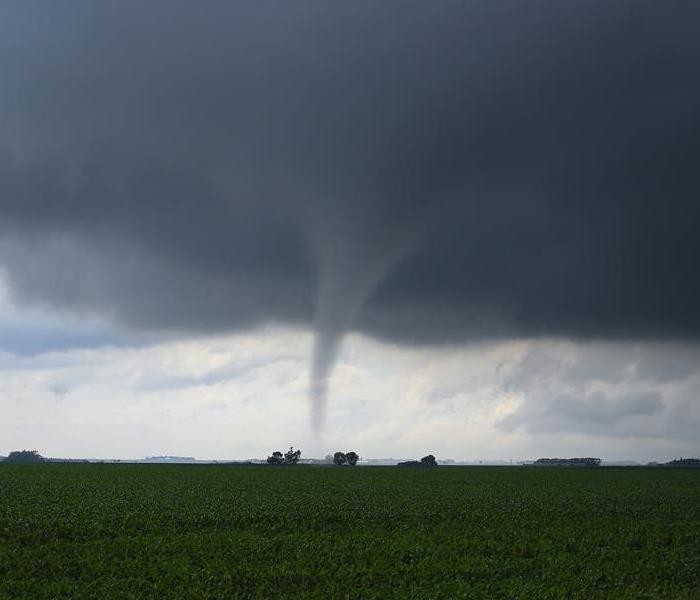 Being aware of storm damage that can occur after a natural disaster such as a tornado, high winds, or lightning strikes.
Being aware of storm damage that can occur after a natural disaster such as a tornado, high winds, or lightning strikes.
When we think of storm damage, our minds often envision torrential rain causing flooding and water damage. While this is indeed a significant concern during storms, it's important to recognize that storm damage can take many other forms as well. From high winds and falling trees to lightning strikes and hailstorms, storms can pose a range of hazards that can wreak havoc on properties. In this blog, we will explore the various types of storm damage beyond rain flooding, helping you better understand and prepare for the potential risks associated with severe weather.
High Winds
One of the most common and destructive aspects of storms is strong winds. These gusts can cause a wide range of damages, including:
- Roof Damage: High winds can lift and dislodge roof shingles, leading to leaks and structural vulnerabilities.
- Siding and Window Damage: Windborne debris can cause cracks, breaks, or even complete detachment of siding and windows.
- Falling Trees and Branches: Powerful winds can uproot trees or break branches, causing significant damage to buildings and surrounding structures.
Lightning Strikes
Lightning during storms can result in severe damage, including:
- Fire Hazards: Lightning strikes can cause fires, leading to devastating property damage.
- Electrical Surges: Power surges resulting from lightning strikes can damage electrical systems, appliances, and electronic devices.
- Hailstorms: Hail, a form of frozen precipitation, can cause substantial damage, such as:
- Roof Damage: Hailstones can puncture or dent roofs, leading to leaks and compromised structural integrity.
Exterior Damage
Siding, windows, and other exterior surfaces may suffer dents, cracks, or shattering due to hail impact after a storm. Vehicle damage from hailstorms can cause extensive damage to vehicles parked outdoors, including dented or shattered windshields and body panels.
Storm Surges
For properties located near coastal areas, storm surges pose a significant threat during hurricanes and tropical storms. These surges involve coastal flooding. In addition to rain flooding, storm surges can cause rapid and severe coastal flooding, leading to widespread property damage.
Tornadoes
In regions prone to tornadoes, these powerful vortexes can cause catastrophic damage, including complete destruction. Tornadoes can level buildings, leaving behind only debris. Tornadoes can cause structural damage and even weaker tornadoes can cause significant structural damage to roofs, walls, and foundations.
While rain flooding is often the primary concern during storms, it's crucial to be aware of the other types of storm damage that can occur. High winds, lightning strikes, hailstorms, storm surges, and tornadoes can all cause severe property damage and pose risks to occupants' safety. By understanding these different forms of storm damage, you can take appropriate measures to mitigate risks, such as reinforcing structures, securing outdoor items, and having emergency plans in place. Remember, comprehensive storm preparedness involves considering all potential hazards to ensure the safety and protection of your property and its occupants.
What Do I Do If My House Floods?
2/22/2023 (Permalink)
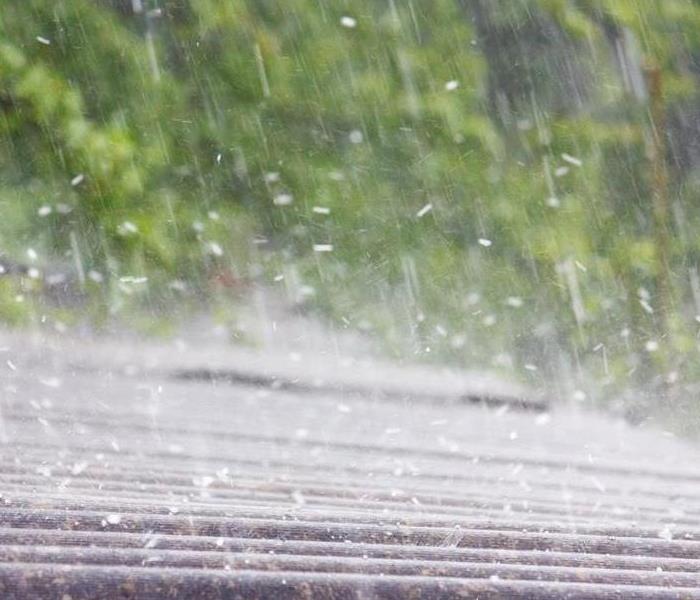 When your property suffers damage from a storm, we are here to help!
When your property suffers damage from a storm, we are here to help!
Rain and flooding can be a huge pain and it's not fun to find out that your house has been flooded. It can take weeks or even several months to get it fixed. But there are things you can do immediately after a flood that will help mitigate the damage as much as possible, and they'll make the process of cleaning up easier in the long run.
Turn off the electricity.
If your house floods, turn off the electricity. If you have a generator, make sure it's not running on gasoline or propane. If it is, turn it off as well.
If there is no power in your home and water levels are rising, unplug all electrical items and appliances that can be moved. You'll also want to remove any computers or televisions as well—they don't need electricity to conduct damage!
Turn off the water supply.
If you can, turn off the water supply. If you can't find the main water valve, turn off the water supply to the house. If it's a flooding emergency, you're not thinking rationally, so don't worry about what's going to happen later when it comes time for repairs. You need to make sure that there is no running water anywhere in your home while you start working on cleaning up and drying out everything that got wet.
Evacuate.
As soon as you realize your house has flooded, the most important thing to do is to evacuate. If you have time, grab any valuables from your home, such as important documents. If not, leave those items behind and go directly to a safe place.
Take any pets with you when evacuating. This will ensure they're cared for while also keeping them away from danger until help arrives.
Document everything.
When you’re dealing with a flood, you should document the damage as soon as possible. Take pictures of things that need to be replaced or repaired, then call your insurance company and make sure they know about it.
Take pictures of the damage. Take pictures of the flood. Take pictures of the water level. Take pictures of all the damage done to your property.
Be sure to include as much detail as possible in your photos, including items that have been damaged and their current condition (i.e., if they are wet or dry). Also, make sure to take multiple shots from different angles so that your insurer can see everything clearly when reviewing them later on.
It's important to let your insurance company know what happened as soon as possible so that they can begin assessing the damage and make sure you're protected.
Begin the mitigation and restoration process immediately.
The first thing you should do after your house floods is to begin the mitigation and restoration process immediately. This means removing all damaged items, cleaning up the mess, and removing any mold that may have formed in your home.
As soon as possible, dry out your house by turning on fans to circulate air throughout the structure and open windows where possible (make sure it's safe first).
Next, repair damage to your house caused by flooding—and replace any belongings or furniture that were destroyed by water damage or mold.
Lastly, restore your home back to its original condition so no one will know what happened there before it gets flooded again!
A flooded house is a big deal. It can be dangerous and a pain to fix, but with some time and hard work, there are things you can do to make it better. If your house floods, turn off the electricity and water supply immediately. Then evacuate the premises until professionals arrive to clean it up or take pictures of any damage caused by the flood. SERVPRO of South Baton Rouge is always here to help with all your flood damage cleanup and restoration needs!
4 Plans To Include Within Your Business Disaster Plan
7/20/2022 (Permalink)
 Are you prepared?
Are you prepared?
Are You Prepared?
Are you prepared for the possible disasters that could happen to your business in Arlington, LA? Ready your facility and employees with these four plans for disaster preparedness.
1. An Involvement Plan
A key component of business preparedness is getting your employees involved. By creating a diverse planning team, you can address employee needs and have a clear plan for getting everyone to safety. The co-workers you choose should also be ready in emergency situations. They know the plan best, so they will be crucial to helping others during an emergency.
2. An Evacuation Plan
Getting everyone out of your facility safely means ensuring that your employees know your evacuation plan inside and out. To prepare them, you need to give them the information they need. Create detailed maps with evacuation routes, locations of safety equipment and assembly places. Post them in high traffic areas such as elevator corridors. Review your plans frequently to make sure they are understood. Conduct drills to give your employees confidence if a real emergency happens.
3. A Shelter-In-Place Plan
Certain emergencies might call for you to stay indoors. “Shelter-In-Place” plans need to consider how to keep your employees safe within your facility. These include tornado warning and air-quality contamination emergencies. Create a diagram of your building for each possible scenario and designate rooms for your employees to go to for each situation.
4. A Post-Disaster Plan
Disaster preparedness includes having a plan for when the emergency is over. Have a list of emergency contacts prepared. Create a communication network to check on employees and relay any important information they will need going forward. Develop a plan to continue servicing your most valued customers. This way, you can continue to work while commercial restoration services get your facility up and operating at full capacity.
Disaster preparedness is a business owner’s responsibility, but by including your employees in your preparation, you will be more prepared for an emergency.
3 Risks of Driving Through Flood Water
6/26/2022 (Permalink)
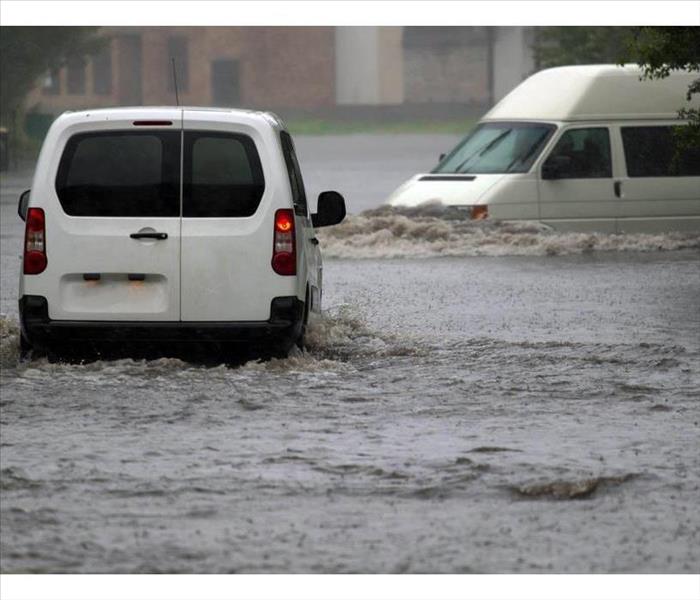 Avoid driving through a flooded street.
Avoid driving through a flooded street.
Driving Through Flood Water Poses Three Dangers
Many of us wouldn’t think twice about driving through a flooded street. After all, what harm can a little H2O do? Fact is, it can do much more damage than you think. Not convinced? Here are a few more reasons why driving through flood water in Baton Rouge, LA, is never a good idea.
About Flood Water
Flash floods are common in areas that are low-lying, but they can happen anywhere that rapid rainfall accumulates. If you doubt the power of flood water, understand that
- It takes just a foot of water to make your car float
- It takes just two feet of water to make the average SUV float
Engine Failure
Car engines aren't meant to be immersed in water. If flood waters are high enough, your engine can do something called hydro locking. This happens with water penetrates the combustion chamber, stopping your vehicle from running and killing your electrical system. That means a stalled car in a flood - not a good thing.
Brake Failure
If your engine doesn't stall out in a flooded street, your brakes just might. That's because your brake components were meant to operate under dry conditions. Water can make it difficult or impossible for brake pads to contact rotors causing you to lose control of your car.
Being Swept Away
Swift-moving water is a force to be reckoned with. It can not only float your car but pick it up and moved down the road! This could leave you colliding with debris or even other vehicles. The Centers for Disease Control and Prevention says that the majority of flood-related drownings come after someone drove into a flood.
Driving through a flooded street might not seem like a big deal, but it can become one fast. Never underestimate how dangerous flooded areas can be. Keep these flood travel tips from storm cleanup experts in mind the next time you think about taking on flooded roads.
How To Prepare For a Severe Storm
6/3/2022 (Permalink)
 Make a safety kit.
Make a safety kit.
Prepare For a Severe Storm
If you are expecting a storm in Gardere, LA, there are some steps that you can take to prepare yourself, your home and your family. The following actions can help reduce water damage to the building and increase your safety.
1. Seal Doors and Windows to Keep Out Flood Water
During a storm, water can make its way inside the building through cracks around doors and windows. Make sure these are closing properly and that the seals around them are not damaged. You may want to place sandbags near entrances for additional protection.
2. Relocate Important Belongings
If you live in a house with multiple stories, move anything that you can to an upper level. This will help reduce damage from flood water. If your home is single-story, place important or valuable items on shelves or inside airtight containers to keep them safe.
3. Make a Safety Kit
It is not only important to keep your belongings safe but also for yourself and your family. The power may go out during a storm, so prepare a kit with flashlights, radios and extra batteries. Canned foods that do not need to be cooked and bottled water should be included as well.
4. Evacuate If Necessary
In some cases, it may not be safe to stay where you are. If it is likely that the area will flood, you should find shelter somewhere safe until the storm passes. If you return to a flooded building, a professional flood damage restoration company can repair your home and clean affected belongings.
Severe weather can cause a lot of trouble, from creating a dangerous environment to filling your home with flood water. Preparing ahead of time can help you get through the situation more safely. Do what you can to protect your home and belongings, and take shelter somewhere else if you need to.
4 Structural Components Prone to Moisture Problems
4/23/2022 (Permalink)
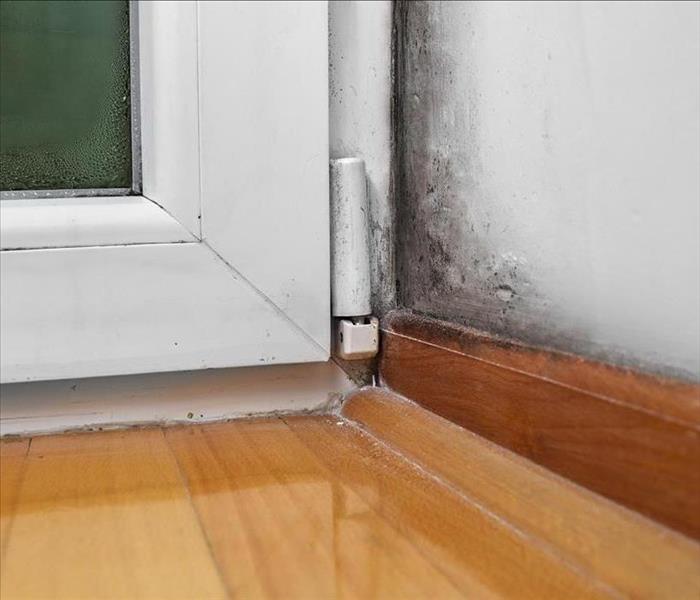 Black mold growth in Baton Rouge, LA.
Black mold growth in Baton Rouge, LA.
Four Moisture-Prone Structural Components
Property owners in Baton Rouge, LA, know a big storm will happen before too long. Ensuring the property is sealed and protected against rain damage is essential to avoiding black mold growing, water losses and potentially expensive repairs. While a certified water damage and restoration company will be able to get your property back to "Like it never even happened," taking preventive measures may minimize the chances of damage happening. To do that, the building envelope—structural components that separate the interior and exterior—must be maintained.
1. Roof
The roof is the main structural component protecting your property. Regular maintenance and annual inspections by a professional are vital to ensuring it does what it should. If the roof is more than 20 years old, it may be time to consider a new one.
2. Doors and Windows
These parts of a building are the most prone to damage. Ensure they always working properly and make necessary repairs as soon as possible. Items to look for include missing screws, loose hinges and worn weather-stripping,
3. Foundation
When it comes to rain damage, finding it in the lower levels of the property is common. Water easily finds its way through any tiny crack or damaged sealant as it follows its natural gravitational path. Along with repairing any damage, ensure the ground outside slopes away from the property.
4. Siding and Masonry
Any gaps, cracks or missing parts open up your property to water infiltration. Signs of siding trouble also include warping and bubbling. For structures with masonry, it may be time for a little upgrade to avoid water issues. It can be reinforced by removing ivy, replacing seals, grouting mortar joints and installing flashing.
As a property owner, you want to keep it in tip-top shape. Regularly inspecting common problem areas and making immediate repairs helps make that happen and minimizes the chances of rain damage.
Flood Water Prevention Methods
4/5/2022 (Permalink)
 A dam can be built from sandbags to block water.
A dam can be built from sandbags to block water.
Methods of Flood Water Prevention
Engineers take considerable leaps to stop high water from flooding city streets and neighborhoods. As a business owner, you should take note of what measures Gardere, LA, has in the event of a natural disaster or flood.
These are some of the common methods:
- Levees are concrete or sand embankments to prevent water overflow.
- Dams block water completely, only allowing an area to flood when necessary.
- Locks allow ships to move from higher water areas to lower areas.
- Dikes are long walls or ditches that prevent the sea from crossing into cities.
- Gates can block water when necessary but open and close to permit traffic and water flow.
Unfortunately, none of these methods are perfect. During storm season, don't let your business be caught unawares by high water. You should be ready to reach out to a water damage remediation company as well as familiarize yourself with how your city protects itself.
Unique Barriers
Some cities have devised unique ways to keep floodwaters from entering business and agricultural districts.
The Maeslant Storm Surge Barrier in the Netherlands is designed to open and close completely. When it is open, the water flows freely. As the water rises, the walls close to stop flooding and fill the adjoining pools with excess water. When the flooding recedes, the barriers open again, returning the channel to normal flow.
The barriers on the River Eden in England are a newer solution for flood prevention. They replace traditional sandbags with hydraulic barriers that can be raised or lowered when necessary. The barriers are now computer-controlled to prevent them from accidentally lowering.
Barriers To Protect Your Business
Along with understanding what your city does to protect against a flood, you should also be prepared to protect your business yourself. A dam can be built from sandbags to block water. Retention ponds, like small versions of the Maeslant Storm Surge Barrier's retention pools, and french drains help control pooling water.
When a storm is coming, there are many things you can do to help safeguard your business from high water conditions.



 24/7 Emergency Service
24/7 Emergency Service







